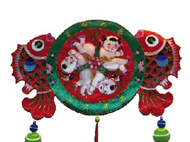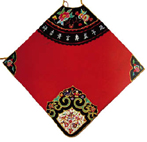|
GUAN Zhong (c. 725-645 B.C.), a prominent politician, reformer, and prime minister of the State of Qi during the Spring and Autumn Period (770-476 B.C.), clearly defined the traditional social division of labor between men and women 2,600 years ago: "A farmer has a constant task, and a woman has a constant chore; if a farmer does not farm, there will be people of hunger as a consequence, and if a woman does not weave, there will be people who have no clothes to keep themselves warm." This division of labor addressed basic human needs and sustained the agricultural society of feudal China for thousands of years, providing the basis from which Chinese culture and Confucianism developed.
In the early days of the "men farming and women weaving" society, the products of women's weaving and collateral activities were referred to as "the work of womanhood," or "nügong" in Chinese. Later the character "gong," meaning "work," was replaced by a more refined homonym that refers to feminine art. The "art of womanhood" encompasses an expanded social connotation of womanhood, from the basic domestic skills required of the gender for human survival, to the moral, temperamental and artistic qualities required by a more sophisticated society.
Inspiration from an Ancient Painting
 |
| An embroider pouch. | Pestling Cloth is painted by Tang Dynasty (618-907) court artist Zhang Xuan, who excelled at depicting women. Many of Zhang's works reflect the lives of female aristocrats, including this one. It depicts one of the daily jobs that constituted "women's work" 1,300 years ago. Pestling was a finishing process in weaving. When silk, linen or cotton cloth came fresh from handlooms it was stiff and needed boiling, bleaching, pestling and ironing before it was ready for making clothes.
There are 12 women in the painting. Judging from their nice clothes and healthy looks, they are court ladies, or women from well-off families. They form a team performing three processes. There are four in the pestling group; two are pounding hard, while the other two look as if they are catching their breath. The central section has two women; one is sorting threads, and the other is sewing. There are six women in the ironing group; one is tending a charcoal fire, three are stretching out a piece of cloth as one is ironing it, while a little girl is frolicking around.
However, such a division of labor was not common among ordinary families, for it required a sizable workspace and multiple hands. Usually housewives performed the work independently and preferred after-tailor pestling, as pestling clothes was much easier to handle by one person when working in a cramped space. They made clothes and did pestling for their family in the evening, while taking care of their children and performing other domestic chores during the day. A line from Li Bai, a great poet of the Tang Dynasty, records the lives of the time: "When moonlight spreads over Chang'an, the sound of pestling clothes arises from thousands of families."
In fact, making clothes was not only a family duty of women, but also their social responsibility. They sewed winter clothes for their sons, brothers, or husbands who had been recruited into military service, and supplied military uniforms to the state as taxes and levies in kind.
Imperial and aristocratic families were no exception, as farming and textiles were foremost priorities of the ruling class. Starting from the Zhou Dynasty 3,000 years ago, royal women raised silkworms and made silk fabrics and clothes. The empress, as the supreme model of womanhood, played a leading role in the job, in order to encourage all the womenfolk to fulfill their expected role.
 |
| Embroidered dudou, or "belly aprons". | This tradition was carried into the Tang Dynasty, when imperial women — court maids and emperor's wives as well — made winter clothes for frontier soldiers as part of their daily work. During the Kaiyuan Reign in the early eighth century, Emperor Xuanzong sent a batch of winter clothes made by the imperial family to a frontier garrison as a token of imperial benevolence. One soldier found a poem in the cotton-padded robe he received. It expressed the feminine sentiment of a young woman for a man whom she did not know but for whom she had sewed clothes with all her tender heart. It concludes with the line: "This life we pass as strangers, may fate unite us in the next life."
The soldier dared not conceal the matter, since all court maids were theoretically the emperor's women, and turned the poem in to his commander, who forwarded it to Emperor Xuanzong. The emperor displayed the poem in the court and promised he would not punish the writer if she came forward. A court maid admitted to composing and sending the poem and asked for the emperor's punishment. Kind-hearted Xuanzong married the maid to the solider who received her poem, saying that he wanted them to be united in this life. When the story reached the frontier garrison, all the soldiers were deeply moved. This poem was later included in The Complete Collection of Tang Dynasty Poetry (Quan Tang Shi, compiled in 1706 on the orders of Qing Emperor Kangxi). It was titled Poem in the Robe, and its writer was identified as "a court maid of the Kaiyuan Reign."
|
